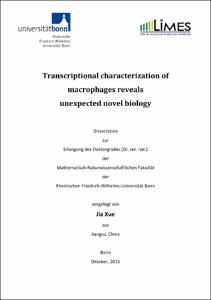Transcriptional characterization of macrophages reveals unexpected novel biology

Transcriptional characterization of macrophages reveals unexpected novel biology

| dc.contributor.advisor | Schultze, Joachim L. | |
| dc.contributor.author | Xue, Jia | |
| dc.date.accessioned | 2020-04-21T10:41:04Z | |
| dc.date.available | 2020-04-21T10:41:04Z | |
| dc.date.issued | 12.11.2015 | |
| dc.identifier.uri | https://hdl.handle.net/20.500.11811/6561 | |
| dc.description.abstract | Macrophages are very plastic and versatile immune cells in response to different environmental signals. Similar phenomenon has been observed for other myeloid compartment, such as monocytes. Moreover, it has been described that different tissue macrophage subpopulations have distinct origins. In this dissertation, I systematically analyzed a large resource dataset to assess transcriptional regulation during human macrophage activation by comparing a diverse set of stimuli on a single microarray platform under highly standardized conditions. Network modeling of this dataset led to the extension of the current M1 versus M2 polarization model to a “multi-dimensional model” with at least nine distinct macrophage activation programs. Applying these transcriptional programs to human in vivo alveolar macrophages from smokers and patients with chronic obstructive pulmonary disease (COPD) revealed an unexpected biology. Reverse engineering of large transcriptional dataset by integrating multiple network inference approaches sharpens the resolution of the common macrophage activation regulatory networks. And the refined network indicated that transcription factors are the most important components in regulatory circuits involved in macrophage activation. Furthermore, by applying the same computational methodologies to a transcriptomic dataset of infected human peripheral blood mononuclear cells (PBMC), I extended my studies to identify common and stimulus-specific transcriptional programs in host defense against bacteria and fungi. By combination of knowledge-based and data-driven analysis, I propose refined pathway models for these microbial infections on transcriptional level. Finally, computational studies on gene expression profiles for embryonic and adult tissue macrophages from both wild type and Irf8-deficient mice revealed distinct origins and transcriptional profiles of different tissue macrophage subpopulations and a crucial role of Irf8 in macrophage ontogeny and homeostasis. Overall, applying systems biology approaches, especially advanced methods on large enough transcriptional datasets enables robust and accurate statistical predictions. Thus, the studies on macrophages or myeloid cells using these approaches successfully uncovered the complex dynamic regulatory networks of these cells and reflected a hitherto unexplored biology. | en |
| dc.language.iso | eng | |
| dc.rights | In Copyright | |
| dc.rights.uri | http://rightsstatements.org/vocab/InC/1.0/ | |
| dc.subject.ddc | 570 Biowissenschaften, Biologie | |
| dc.title | Transcriptional characterization of macrophages reveals unexpected novel biology | |
| dc.type | Dissertation oder Habilitation | |
| dc.publisher.name | Universitäts- und Landesbibliothek Bonn | |
| dc.publisher.location | Bonn | |
| dc.rights.accessRights | openAccess | |
| dc.identifier.urn | https://nbn-resolving.org/urn:nbn:de:hbz:5n-41915 | |
| ulbbn.pubtype | Erstveröffentlichung | |
| ulbbnediss.affiliation.name | Rheinische Friedrich-Wilhelms-Universität Bonn | |
| ulbbnediss.affiliation.location | Bonn | |
| ulbbnediss.thesis.level | Dissertation | |
| ulbbnediss.dissID | 4191 | |
| ulbbnediss.date.accepted | 27.10.2015 | |
| ulbbnediss.institute | Mathematisch-Naturwissenschaftliche Fakultät : Fachgruppe Molekulare Biomedizin / Life & Medical Sciences-Institut (LIMES) | |
| ulbbnediss.fakultaet | Mathematisch-Naturwissenschaftliche Fakultät | |
| dc.contributor.coReferee | Hofmann-Apitius, Martin |
Files in this item
This item appears in the following Collection(s)
-
E-Dissertationen (4337)




